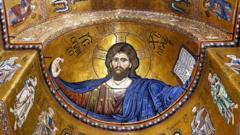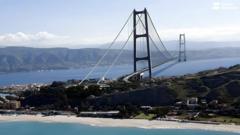The Monreale Cathedral, perched above Palermo on a Sicilian hill, is not just a significant religious structure, but a treasure trove of art history, celebrated for housing the largest Byzantine-style mosaics in Italy. Since being named a UNESCO World Heritage site in 2015, it has undergone extensive restoration to revive its original glory, proving to be a monumental undertaking.
The mosaics, which span over 6,400 square meters and use approximately 2.2 kilograms of solid gold, were designed to impress and inspire visitors just as they did during the era of the Byzantine Empire. Recent restoration efforts, led by local experts from the Italian Ministry of Culture, included meticulous cleaning, repairing tiles that had lost their enamel, and addressing areas where tiles were peeling off the walls.
Father Nicola Gaglio, a priest associated with the cathedral for 17 years, expressed the gravity of overseeing such a delicate restoration process. "The team approached this work almost on their tiptoes,” he reflected, detailing the challenges they faced, such as discovering a yellowed varnish on the ceiling during restoration efforts.
The previous restoration dated back to 1978, but this latest initiative had a broader scope. It included upgrading the cathedral's lighting system to highlight the vivid colors of the mosaics beautifully. Matteo Cundari, Country Manager of Zumtobel, emphasized the aim of achieving optimal lighting while also allowing for future adjustments without damaging the historic structure.
The restoration project, costing approximately 1.1 million euros, is only the first phase. Plans for a second phase focused on the cathedral's central nave are already underway. “When you see it, you're overwhelmed with awe, and you can't really think of anything. It's pure beauty,” Father Gaglio expressed, reinforcing the cathedral's role as a keeper of world heritage and a reminder of humanity's innate beauty.
The mosaics, which span over 6,400 square meters and use approximately 2.2 kilograms of solid gold, were designed to impress and inspire visitors just as they did during the era of the Byzantine Empire. Recent restoration efforts, led by local experts from the Italian Ministry of Culture, included meticulous cleaning, repairing tiles that had lost their enamel, and addressing areas where tiles were peeling off the walls.
Father Nicola Gaglio, a priest associated with the cathedral for 17 years, expressed the gravity of overseeing such a delicate restoration process. "The team approached this work almost on their tiptoes,” he reflected, detailing the challenges they faced, such as discovering a yellowed varnish on the ceiling during restoration efforts.
The previous restoration dated back to 1978, but this latest initiative had a broader scope. It included upgrading the cathedral's lighting system to highlight the vivid colors of the mosaics beautifully. Matteo Cundari, Country Manager of Zumtobel, emphasized the aim of achieving optimal lighting while also allowing for future adjustments without damaging the historic structure.
The restoration project, costing approximately 1.1 million euros, is only the first phase. Plans for a second phase focused on the cathedral's central nave are already underway. “When you see it, you're overwhelmed with awe, and you can't really think of anything. It's pure beauty,” Father Gaglio expressed, reinforcing the cathedral's role as a keeper of world heritage and a reminder of humanity's innate beauty.

















